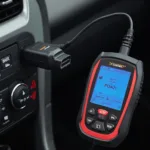Using an OBD2 scanner has become essential for understanding and maintaining your vehicle’s health. From identifying a check engine light’s cause to monitoring fuel efficiency, these powerful diagnostic tools empower car owners and professionals alike. This comprehensive guide will explore everything you need to know about using an OBD2 scanner effectively.
Understanding the Power of the OBD2 Scanner
The OBD2 (On-Board Diagnostics II) system is a standardized system found in most vehicles manufactured after 1996. It acts as your car’s internal communication network, constantly monitoring various systems and sensors. When a problem arises, the OBD2 system stores a diagnostic trouble code (DTC), which an OBD2 scanner can retrieve and interpret. This allows you to pinpoint the issue and take appropriate action. Using an OBD2 scanner not only saves you time and money on potential repairs but also provides valuable insights into your vehicle’s overall performance. Are you ready to unlock the secrets hidden within your car’s computer?
How to Use an OBD2 Scanner: A Step-by-Step Guide
Using an OBD2 scanner is surprisingly straightforward, even for beginners. Here’s a detailed guide to get you started:
- Locate the OBD2 port: This port is typically found under the dashboard on the driver’s side.
- Plug in the scanner: Connect the OBD2 scanner to the port. Make sure the connection is secure.
- Turn on the ignition: Turn the key to the “on” position without starting the engine. This powers up the OBD2 system.
- Power on the scanner: Most scanners power on automatically when connected. If not, turn it on manually.
- Select the appropriate options: Follow the on-screen prompts to select the desired functions. This might involve choosing the vehicle’s make and model or selecting specific diagnostic tests.
- Read the codes: The scanner will retrieve and display any stored DTCs. Note down these codes.
- Interpret the codes: Use a reliable resource like a repair manual or an online database to decipher the codes and understand the corresponding issues.
- Clear the codes: After addressing the issue, use the scanner to clear the codes from the OBD2 system.
- Retest: After a few driving cycles, rescan to ensure the issue has been resolved.
Beyond the Basics: Advanced OBD2 Scanner Features
While reading and clearing codes is the primary function, many OBD2 scanners offer advanced features:
- Live Data Streaming: Monitor real-time sensor data like engine RPM, coolant temperature, and oxygen sensor readings. This provides invaluable insights into your vehicle’s performance and can help diagnose intermittent issues.
- Smog Check Readiness: Check if your vehicle is ready to pass emissions testing.
- Freeze Frame Data: Capture a snapshot of sensor data at the moment a fault code was stored.
- ABS and SRS Diagnostics: Some scanners can access and diagnose issues within the Anti-lock Braking System (ABS) and Supplemental Restraint System (SRS). You might consider using obd2 scanner to check fuel pump.
“Regularly using obd2 scanner 1992 or newer vehicles allows you to be proactive with maintenance, saving money on costly repairs down the line,” says automotive expert, David Miller, ASE Master Technician.
Choosing the Right OBD2 Scanner
With a wide range of scanners available, choosing the right one can feel overwhelming. Consider these factors:
- Compatibility: Ensure the scanner is compatible with your vehicle’s make, model, and year.
- Features: Determine the features you need based on your level of expertise and diagnostic requirements.
- Budget: Scanners range from affordable basic models to high-end professional tools.
- User-friendliness: Choose a scanner with an intuitive interface and easy-to-understand instructions.
You can find more information on how to run code use an obd2.
“Investing in a quality OBD2 scanner is like having a personal mechanic in your pocket,” adds Sarah Chen, Lead Engineer at Auto Diagnostics Inc. “It empowers you to understand your vehicle better and take control of its maintenance.” You could also consider using obd2 scanner at dealership.
Conclusion
Using an OBD2 scanner is an invaluable skill for any car owner. From diagnosing check engine lights to monitoring vehicle performance, these tools offer a wealth of information and control. By understanding the basics and exploring the advanced features, you can effectively use an OBD2 scanner to keep your car running smoothly and save money on potential repairs. Don’t let your car’s health be a mystery; embrace the power of the OBD2 scanner today! You can also explore obd2 scanner to bleed gm abs brakes android.
Need assistance? Contact us via WhatsApp: +1(641)206-8880, Email: [email protected] or visit us at 789 Elm Street, San Francisco, CA 94102, USA. We offer 24/7 customer support.
